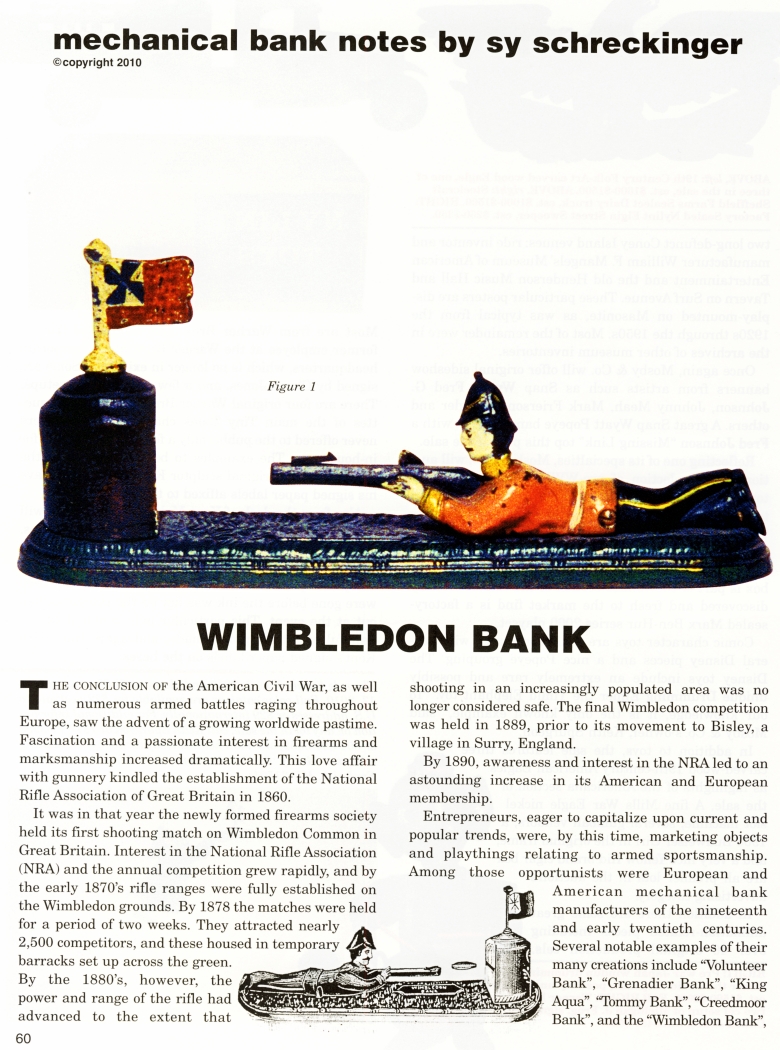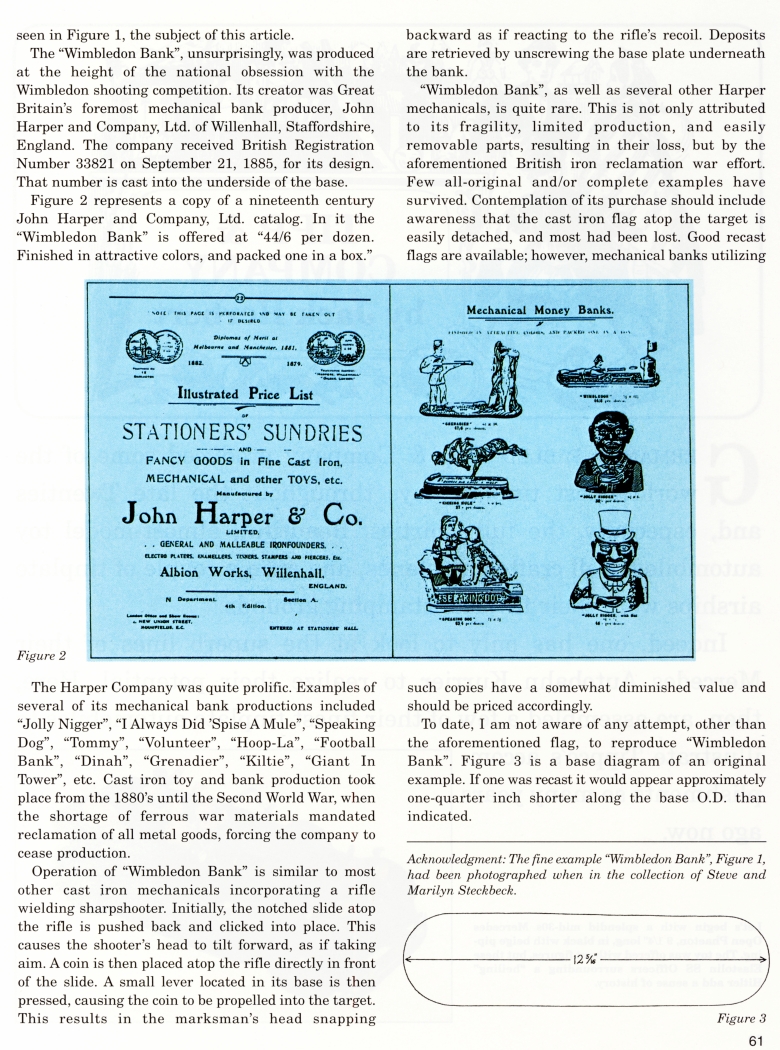|
Wimbledon Bank
by Sy Schreckinger – ANTIQUE TOY WORLD Magazine – November, 2010
THE
CONCLUSION OF the American Civil War, as well as numerous armed battles
raging throughout
Europe, saw the advent of a growing worldwide pastime. Fascination and a
passionate interest in firearms and marksmanship increased dramatically.
This love affair with gunnery kindled the establishment of the National
Rifle Association of Great Britain in 1860.
It was in that year the newly formed firearms society held its first
shooting match on Wimbledon Common in Great Britain. Interest in the
National Rifle Association (NRA) and the annual competition grew
rapidly, and by the early 1870's rifle ranges were fully established on
the Wimbledon grounds. By 1878 the matches were held for a period of two
weeks. They attracted nearly 2,500 competitors, and these housed in
temporary barracks set up across the green. By the 1880's, however, the
power and range of the rifle had advanced to the extent that shooting in
an increasingly populated area was no longer considered safe. The final
Wimbledon competition was held in 1889, prior to its movement to Bisley,
a village in Surry, England.
By 1890, awareness and interest in the NRA led to an astounding increase
in its American and European membership.
Entrepreneurs, eager to capitalize upon current and
popular trends, were, by this time, marketing objects
and playthings relating to armed sportsmanship.
Among those opportunists were European and
American mechanical bank
manufacturers of the nineteenth
and early twentieth centuries.
Several notable examples of their
many creations include "Volunteer
Bank", "Grenadier Bank", "King
Aqua", "Tommy Bank", "Creedmoor
Bank", and the "Wimbledon Bank",
seen in Figure 1, the subject of this article.
The "Wimbledon Bank", unsurprisingly, was produced at the height of the
national obsession with the Wimbledon shooting competition. Its creator
was Great Britain's foremost mechanical bank producer, John Harper and
Company, Ltd. of Willenhall, Staffordshire, England. The company
received British Registration Number 33821 on September 21, 1885, for
its design. That number is cast into the underside of the base.
Figure 2 represents a copy of a nineteenth century John Harper and
Company, Ltd. catalog. In it the "Wimbledon Bank" is offered at "44/6
per dozen. Finished in attractive colors, and packed one in a box."
The Harper Company was quite prolific. Examples of several of its
mechanical bank productions included "Jolly Nigger", "I Always Did
'Spise A Mule", "Speaking Dog", "Tommy", "Volunteer", "Hoop-La",
"Football Bank", "Dinah", "Grenadier", "Kiltie", "Giant In Tower", etc.
Cast iron toy and bank production took place from the 1880's until the
Second World War, when the shortage of ferrous war materials mandated
reclamation of all metal goods, forcing the company to cease production.
Operation of "Wimbledon Bank" is similar to
most other cast iron mechanicals incorporating a rifle wielding
sharpshooter. Initially, the notched slide atop the rifle is pushed back
and clicked into place. This causes the shooter's head to tilt forward,
as if taking aim. A coin is then placed atop the rifle directly in front
of the slide. A small lever located in its base is then pressed, causing
the coin to be propelled into the target. This results in the marksman's
head snapping
backward as if reacting to the rifle's recoil. Deposits are retrieved by
unscrewing the base plate underneath the bank.
"Wimbledon Bank", as well as several other Harper mechanicals, is quite
rare. This is not only attributed to its fragility, limited production,
and easily removable parts, resulting in their loss, but by the
aforementioned British iron reclamation war effort. Few all-original
and/or complete examples have survived. Contemplation of its purchase
should include awareness that the cast iron flag atop the target is
easily detached, and most had been lost. Good recast flags are
available; however. mechanical banks utilizing such
copies have a somewhat diminished value and should be priced
accordingly.
To date, I am not aware of any attempt, other than the aforementioned
flag, to reproduce "Wimbledon Bank". Figure 3 is a base diagram of an
original example. If one was recast it would appear approximately
one-quarter inch shorter along the base O.D. than indicated.
Acknowledgment: The fine example "Wimbledon Rank", Figure 1. had been
photographed when in the collection of Steve and Marilyn Steckbeck.
|


